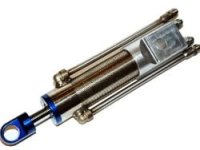In a recent study, Professor Lei Zuo, Brian Scully, Jurgen Shestani, and Yu Zhou, all mechanical engineers from the State University of New York at Stony Brook, have designed and tested a retrofit regenerative shock absorber that recovers a vehicle's vibrational energy. The researchers built a 1:2 scale prototype of the regenerative shock absorber, and demonstrated its ability to harvest 2-8 watts of power during typical driving conditions at a speed of about 45 mph. They predict that a full-scale system on a four-wheel car should be able to recover up to 256 watts under these driving conditions.
“For typical driving conditions, we are predicting the ability to harvest approximately 64 watts per wheel, for a total of approximately 256 watts,†Zuo told PhysOrg.com. “This value increases considerably when the system is used on irregular roads.â€Â
The purpose of the shock absorber in a vehicle's suspension system is to reduce the vehicle’s vibration by dissipating the vibrational energy. About 10 years ago, researchers began looking into recovering the vibrational energy using various magnetic devices. In general, these systems work by first absorbing the kinetic energy of suspension vibration between the wheel and a sprung mass, and then converting that energy into useful electric power.
Zuo and his team’s shock absorber consists of two tube-like components: a smaller magnetic tube slides inside a larger, hollow coil tube. The coil component is made of copper coils wound around a plastic delrin tube, while the magnetic component is made of ring-shaped magnets separated by ring-shaped magnetically permeable spacers. The magnets are aligned with like-poles facing each other to produce a radially emitted magnetic flux. The magnetic tube is also surrounded by a high magnetically permeable material in order to further “pull†the magnetic flux outward. As Zuo explained, having a high magnetic flux is key to the design.
“The power we regenerate is proportional to the square of the magnetic flux across the coils,†he said. “Therefore, if we increase the flux by two times, the peak power output will increase by four times.â€Â



